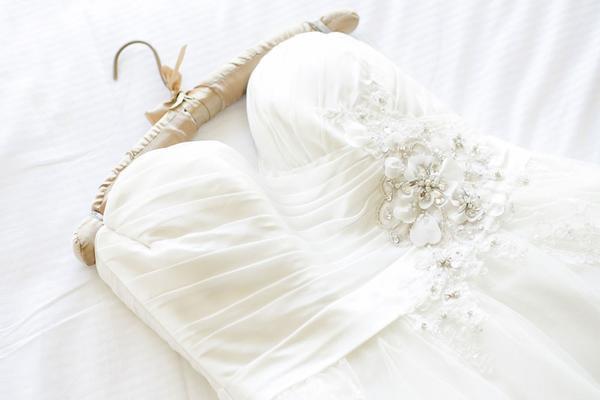The preferable answer to this question begins and ends with professional cleaning services, but what are some other ways that you can take your dress and do some of your own dirty work, so to speak?
Keep in mind that attempting to clean your own wedding dress at home can become a risky business. A lot of these designs are made with delicate fabrics and intricate accents that professionals are trained to care for. But, for those wanting a cost-effective strategy and a try with their own hands, here’s a rundown on how to approach the task.
Approaching Different Fabrics
Some fabrics are trickier than others. Some may shrink in the wash and others may tear. Some may not even fit inside of your washer – like those tulle ball gowns. It’s important to do some research on the fabric of your gown and learn how to care for it appropriately. Here are some of the most popular options:
Charmeuse: This delicate fabric can be hand washed in cold water or put in the washing machine on a gentle/delicate setting.
Lace: Hand washing is definitely the way to go when it comes to getting your lace wedding gown cleaned. Do it in cold water to reduce the possibility of shrinking and avoid the washing machine completely.
Organza: Like charmeuse, organza is a silk option but a bit lighter in feel. Opt for hand washing.
Chiffon: If you are nixing the dry cleaning option on your chiffon gown, the safest route to take is hand washing. You don’t want this soft fabric to rip inside your machine.
Polyester: This material is usually blended with others. It can be both hand-washed or placed on the gentle cycle in the washing machine. Use your judgment here.
Rayon: Same with polyester, this is a blendable fabric that can withstand both hand washes and machine wash cycles. Use your judgment.
Jersey: This stretchy option is becoming a more popular choice among brides. Check the tag on this one, it may give you specific instructions. When in doubt, hand wash but watch out for the possibility of shrinkage.
Taffeta: These gowns can go either way. You may want to check the tag depending on its designer but hand washing in lukewarm water is a safe route to take.
Tulle: A lot of tulle gowns won’t even be able to fit in washing machines although they can withstand those cycles (just place them on gentle). Use your best judgment when deciding which route to take here.
Stain Removal Techniques
Oil-Based Stains (Food or Baby Oil): Dish soap and white vinegar will be your friend with these ones. Tap the stain with a cloth or Q-tip and try to remove as much as you can.
Grass Stains: These ones are really tricky as they’re usually only at the bottom hem of a dress that’s been worn outside and a lot of advice points in the direction of leaving this one to a professional cleaner. But, if you want to take it in your own hands, try mixing water and laundry detergent together and then allowing the solution to sit on the stain for about twenty minutes. After the solution is allowed to sink in, rinse the stain.
Earth-Based Stains (Sode, Wine, Juice): Get it wet immediately. Preferably, add a bit of dish soap in its flushing. If that doesn’t do the trick, try adding some bleach in as well.
Dirt or Clay Stains: Grab a dry towel and rub away what you can before going in with a damp cloth. Once damp though, do not rub. Instead, just delicately brush off as much as possible.
Protein-Based Stains (i.e. blood or sweat): Don’t go in for the kill with chemicals here. Instead, dab off as much as you can – dab, NOT RUB – before creating a homemade solution. Water, ammonia, peroxide, and dish soap come together to create a mixture that can help remove these kinds of stains. But do so with a delicate hand.
Lipstick Stains: This is the doomsday stain of all stains and there’s no real solution to getting these out completely. Instead, it’s best to just steer clear of the possibility altogether. Wait to put your lipstick on until after you’ve shimmied into the gown and give all ladies in the vicinity a warning when they come in for a hug.
Other Makeup Stains (i.e. foundation or blush): These aren’t as tricky as lipstick. In fact, you can usually dab these with water or makeup remover to get them out.
Attention To Delicate Details
The details on your gown must be considered within the washing process. Throwing a gown with a beaded bodice into the washer will cause quick tragedy. Instead, take into consideration all accents surrounding your dress and decide how you will deal with each.
Beadwork, appliques, sashes, etc, should all be removed before you begin the actual cleaning process (whether by hand or machine). This will ensure that these items are not lost or damaged. You just need to be sure you know how to re-apply them.
Hand Washing vs. Machine Washing
Hand washing is a completely acceptable way to get your wedding dress clean but there are some considerations. Check the fabric of your gown and make sure that it can be hand washed. Just like some of your best pieces of clothing have tags that say, “dry clean only,” the same can go for these designs.
As mentioned previously, some fabrics can be damaged by handwashing (or machine washing) so make sure that your velvet or linen gown won’t be caused any harm in the process. Also, before you get started, you’ll want to remove as many embellishments as possible. We stressed this before as well, but those beads or appliques can be completely ruined or lost while washing.
Machine washing is very, very tricky and is never recommended as an outlet for washing wedding gowns. This really only works for the simplest of designs and after you’ve followed all the aforementioned steps including detaching appliques or other embellishments, and even going as far as turning the dress inside out.
Drying Options
There aren’t many options when it comes to drying. No matter if you’ve decided to hand wash or machine wash your gown, you’ll want to dry it the same way.
Absolutely never squeeze or twist your gown to get any water out. Instead, you’ll want to spread your dress out on a flat surface and allow it to air dry. Do not put it in the light (as the sun can cause it to fade or yellow) and don’t put it in a spot that’s too hot or too cold.


